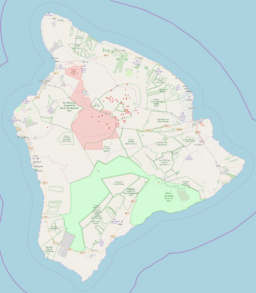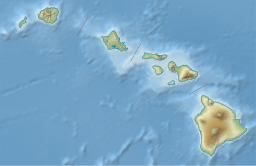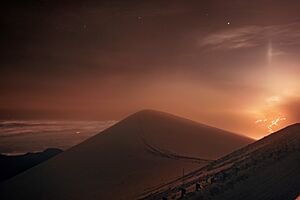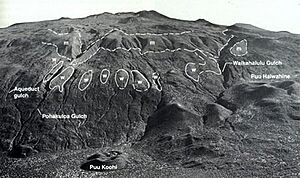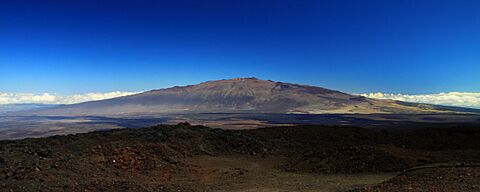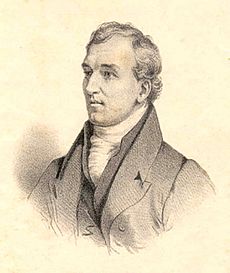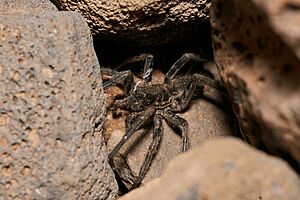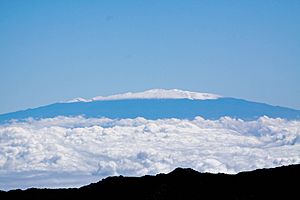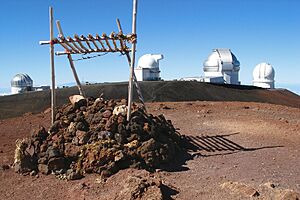Mauna Kea facts for kids
Quick facts for kids Mauna Kea |
|
|---|---|
| Maunakea | |
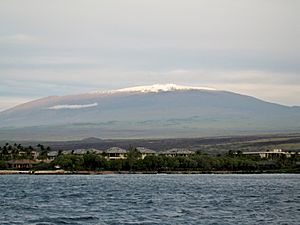
Mauna Kea in December 2007, with its seasonal snow cap visible
|
|
| Highest point | |
| Elevation | 4,207.3 m (13,803 ft) |
| Prominence | 4,207.3 m (13,803 ft) |
| Isolation | 3,947 km (2,453 mi) |
| Listing |
|
| Geography | |
| Location | Hawaiʻi County, Hawaiʻi, United States |
| Parent range | Hawaiian Islands |
| Geology | |
| Age of rock | Oldest dated rock: 237,000 ± 31,000 years BP Approximate: ~1 million years |
| Mountain type | Shield volcano Hotspot volcano |
| Volcanic arc/belt | Hawaiian–Emperor seamount chain |
| Last eruption | 2460 BCE ± 100 years |
| Climbing | |
| First ascent | Recorded: Goodrich (1823) |
| Easiest route | Mauna Kea Trail |
| Designated: | November 1972 |
Mauna Kea (which means Mauna a Wākea or "white mountain") is a huge, sleeping volcano on the island of Hawaiʻi. Its top is about 4,207 meters (13,802 feet) above the ocean. This makes it the highest point in Hawaii. It is also the second highest point on an island in the world, after New Guinea.
Mauna Kea is special because it rises so much from its base. If you measure it from the bottom of the ocean, it is about 9,330 meters (30,610 feet) tall. This makes some people call it the tallest mountain in the world! It is much older than its neighbor, Mauna Loa. Mauna Kea last erupted between 4,000 and 6,000 years ago, so it is considered dormant (sleeping).
For native Hawaiians, the peaks of Hawaiʻi are very special and sacred. Only high-ranking chiefs were allowed to visit the top of Mauna Kea long ago. People living on its slopes used the forests for food and gathered rocks for tools. When Europeans arrived, they brought animals like cattle and sheep. These animals became wild and started to harm the volcano's natural environment.
Mauna Kea has different types of nature zones as you go up its slopes. There is a cold, high-up area, a forest of māmane and naio trees, and a lower forest that was mostly cut down for sugar farms. Today, people are working to protect the native plants and animals by removing the wild animals.
Because it is so high, dry, and has clear air, Mauna Kea's summit is one of the best places in the world to look at space. Since a road was built in 1964, 13 telescopes from different countries have been built there. These telescopes are used for amazing scientific research. However, building these telescopes on a sacred mountain has caused some disagreements.
Contents
How Tall is Mauna Kea?
Mauna Kea is very tall, especially when you measure it from its base deep under the ocean. This is called its "dry prominence." Its peak is 4,207.3 meters (13,802 feet) above sea level. This makes it the highest point in Hawaii.
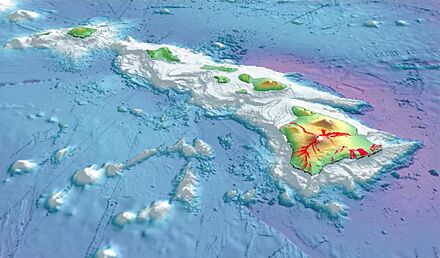
Because the Hawaiian Islands go very deep into the ocean, Mauna Kea's dry prominence is 9,330 meters (30,610 feet). This is even taller than Mount Everest's height above sea level, which is 8,848.86 meters (29,031.7 feet). This is why some experts say Mauna Kea is the tallest mountain in the world from its base to its peak.
How Mauna Kea Was Formed
Mauna Kea is one of five volcanoes that make up the island of Hawaiʻi. This island is the largest and newest in the Hawaiian–Emperor seamount chain. Mauna Kea is the fourth oldest and fourth most active of these five volcanoes.
It started forming about one million years ago. It was very active until about 500,000 years ago. Mauna Kea entered its quieter "post-shield stage" about 200,000 to 250,000 years ago. Its last eruption was between 4,500 and 6,000 years ago.
Mauna Kea does not have a large caldera (a big bowl-shaped crater) at its top. Instead, it has many smaller cinder and pumice cones near its summit. These cones were built by later eruptions that filled in any older caldera.
Mauna Kea is so huge that it and its neighbor, Mauna Loa, push down the ocean floor beneath them by about 6 kilometers (3.7 miles).
The volcano is still slowly flattening under its own weight. This happens at a very slow rate, less than 0.2 millimeters (0.0079 inches) per year.
Like all Hawaiian volcanoes, Mauna Kea was created as the Pacific tectonic plate moved over a hotspot in the Earth's mantle. This process has been going on for over 70 million years, creating the long Hawaiian Ridge–Emperor seamount chain.
Lava flows from Mauna Kea mixed with those from nearby volcanoes as it grew. For example, Mauna Kea is built on older flows from Kohala to the northwest. It also meets the base of Mauna Loa to the south.
The lava that built the main part of the volcano was a type called tholeiitic basalt. Later, the lava became thicker and stickier, forming the steeper slopes of Mauna Kea. Explosive eruptions also built the cinder cones near the summit. These cones are the most recent places where Mauna Kea has erupted.
Mauna Kea is the only Hawaiian volcano that clearly shows signs of glaciers. Even though Hawaii is in a tropical area, during past ice ages, the temperature dropped enough for snow to stay on the summit all summer. This led to the formation of an ice cap. There have been three periods of glaciation in the last 180,000 years. These glaciers carved out the summit, leaving behind rocks and gravel.
Small streams, fed by rain and melting snow, flow only during winter. On the side of the volcano facing the wind, water erosion has shaped the land, similar to older volcanoes like Kohala.
Lake Waiau: A High-Altitude Lake
Mauna Kea is home to Lake Waiau, the highest lake in the Pacific Basin. It is located at an altitude of 3,969 meters (13,022 feet) inside a cinder cone called Puʻu Waiau. It is the only alpine lake in Hawaii. The lake is very small and shallow, only about 3 meters (10 feet) deep when it is full.
Hawaiian lava usually lets water soak through, so lakes don't often form. But at Lake Waiau, special volcanic ash or fine ash from explosive eruptions made the lake bed less permeable, allowing water to collect.
Future Eruptions
Mauna Kea's last eruption was about 4,600 years ago. Because it has been quiet for so long, it is considered a low-hazard volcano.
Even though it is sleeping, Mauna Kea is expected to erupt again someday. Based on past eruptions, a future event could happen anywhere on its upper slopes. It would likely produce long lava flows, about 15 to 25 kilometers (9 to 16 miles) long. If it erupts for a long time, it could build a new cinder cone. While an eruption is not likely in the next few centuries, it would probably not cause many deaths but could damage buildings and roads.
Mauna Kea's Human Story
Ancient Hawaiian Life
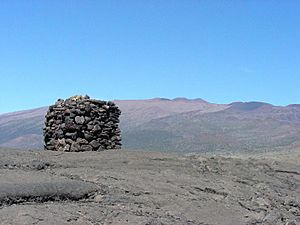
The first Ancient Hawaiians settled along the coast where food and water were easy to find. Later, in the 12th and 13th centuries, people started to live further inland, in the Mauna Loa – Mauna Kea area. They used these areas for hunting, gathering stone for tools, and perhaps for spiritual reasons or to watch the stars.
The forests on the mountain provided food and materials for homes. Birds that had never seen predators became an important food source. However, the arrival of ancient Hawaiians also changed the environment. They brought new plants and animals, like the Polynesian rat, which caused many native bird species to disappear.
The five volcanoes of Hawaiʻi are seen as sacred mountains. Mauna Kea's summit, being the highest, is the most sacred. An ancient Hawaiian law, called kapu, meant that only high-ranking chiefs could visit the peak. In Hawaiian mythology, the summit of Mauna Kea was known as the "region of the gods." The goddess of snow, Poliʻahu, also lives there.
Around the year 1100 AD, native people built adze (tool) quarries high on Mauna Kea. They used the special, dense basalt rock from these quarries to make tools. This rock was formed when hot lava met glacial ice during eruptions. Lake Waiau provided drinking water for the workers. Chiefs would also dip the umbilical cords of newborn babies in the lake's water, believing it would give them the strength of the mountain.
Modern History and Changes
When Europeans and Americans arrived in the late 1700s and early 1800s, it greatly changed life on the island. Native Hawaiians suffered from new diseases. Trading ports like Hilo grew, and the tool quarries on Mauna Kea were no longer used because people now had metal tools.
In 1793, George Vancouver brought cattle to the island. By the early 1800s, these cattle had escaped and roamed freely, causing a lot of damage to the island's natural environment. Later, John Palmer Parker started a large cattle ranch on the northern slope of Mauna Kea, which still exists today. Settlers also cut down much of the lower native forest for sugarcane farms and homes.
The Saddle Road, which crosses the plateau between Mauna Kea and Mauna Loa, was finished in 1943. This made it much easier to travel to Mauna Kea.
The Pohakuloa Training Area on the plateau is the largest military training ground in Hawaii. This base covers a large area on the volcano's lower slopes. It is home to many threatened and endangered plants and animals.
Since the 1980s, many archaeological studies have taken place on Mauna Kea. Researchers have found shrines, tool workshops, and possible burial sites. These findings help us understand how ancient Hawaiians used and respected the mountain.
Climbing Mauna Kea
In ancient times, native Hawaiians likely followed natural paths and water sources to go up Mauna Kea. They would visit family shrines near the summit. However, very few people reached the very top because of the strict kapu (sacred law).
Some of the earliest recorded climbs by foreigners include:
- In 1823, Joseph F. Goodrich, an American missionary, made the first recorded climb in one day.
- In 1825, a team from the ship HMS Blonde, led by botanist James Macrae, reached the summit. Macrae was the first to describe the Mauna Kea silversword plant.
- In 1834, David Douglas, a botanist, climbed the mountain and wrote about the different plants at different heights. He later died on the island, likely from an accidental fall.
- In 1881, Queen Emma traveled to the peak to bathe in Lake Waiau.
- In 2021, Victor Vescovo and Clifford Kapono made a unique ascent. They started from the mountain's base deep underwater in a submersible, then kayaked to shore, biked partway up, and finally walked to the summit.
Before 1964, it was very hard to drive to the summit. Today, there are several hiking trails. Over 100,000 tourists and 32,000 vehicles visit the Visitor Information Station (VIS) each year. It is strongly recommended to use a four-wheel drive vehicle to drive to the top. Visitors should also prepare for altitude sickness by spending time at lower elevations first.
Mauna Kea's Wildlife and Plants
Unique Ecosystems
Hawaiʻi's remote location means it has many unique species found nowhere else. These endemic species are special but also very vulnerable to extinction and invasive species. About one-third of the island's native species have already disappeared.
Mauna Kea has the most diverse ecosystems in Hawaii because of its different elevations. The ecosystems form rings around the mountain due to changes in temperature and rainfall. They can be divided into three main zones:
- Alpine: The cold, high-up area above the tree line.
- Montane: The forest zone in the middle.
- Basal forest: The lower forest at the base.
When Americans and Europeans arrived, they brought new animals and plants that harmed the native ecosystems. Wild animals that escaped from ranches damaged the native forests. Also, there are now over 4,600 introduced plant species on the island, compared to only about 1,000 native species.
Alpine Environment: Life at the Top
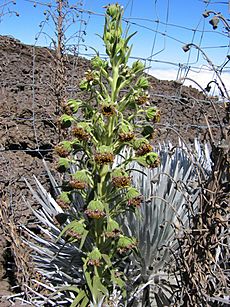
The summit of Mauna Kea is above the tree line. It is mostly lava rock and alpine tundra. It snows a lot here, and the cold temperatures, short growing season, and low rainfall make it hard for plants to grow. The soil is also very poor at holding water.
One special plant found here is the Mauna Kea silversword. This highly endangered plant grows in the high-elevation cinder deserts. It was once thought to only grow in the alpine zone, but it was actually pushed there by grazing animals.
The Mauna Kea Ice Age Reserve protects this area. It is a home for the threatened ʻuaʻu (Hawaiian petrel) bird. It is also where scientists study wēkiu bugs (Nysius wekiuicola).
Wēkiu bugs eat dead insects that are blown up the mountain and land on snow banks. This is unusual for their type of bug, which usually eats seeds. They can survive in the extreme cold because they have natural antifreeze in their blood. They also hide under warm rocks. Other insects like wolf spiders and moths also live in this cold environment.
Māmane–Naio Forest: A Special Home

The forest zone on the volcano, between 2,000 and 3,000 meters (6,600 and 9,800 feet) high, is mostly made up of māmane (Sophora chrysophylla) and naio (Myoporum sandwicense) trees. Both are native to Hawaii. This area is called the māmane–naio forest.
The seeds of māmane and fruits of naio are the main food for birds here, especially the palila (Loxioides bailleui). The palila bird used to live on several volcanoes but is now only found on Mauna Kea. It is a critically endangered species.
The biggest danger to this forest is grazing by wild sheep, cattle, and goats. These animals were brought to the island in the late 1700s. They eat the native plants and compete with commercial grazing animals.
In the 1920s, there was a program to remove these wild animals. But later, local hunters wanted them for sport. This led to a conflict between ranchers, hunters, and conservationists. Eventually, environmental groups sued the Hawaiʻi Department of Land and Natural Resources.
The court ruled that the state had to remove all wild animals from the mountainside to protect the endangered palila bird. This decision helped protect the ecosystem. Today, there is an active program to control these animals, but many other species and ecosystems on Mauna Kea are still threatened.
The Mauna Kea Forest Reserve protects a large area of māmane-naio forest. Hunting of hoofed animals is allowed there all year.
Lower Environment: Forests and Farmland
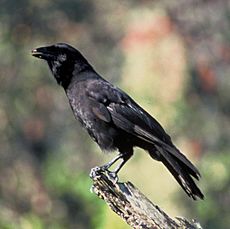
The lower slopes of Mauna Kea used to have large forests of Acacia koa and Metrosideros polymorpha (koa-ʻōhiʻa) trees. But when European and American settlers arrived in the 1800s, much of this forest was cut down for lumber and to make room for sugarcane farms. By the early 1900s, most of this vast forest was gone.
After the sugar industry declined in the 1990s, much of this land was left unused. Some parts are now used for cattle grazing, small farms, and growing eucalyptus trees for wood pulp.
The Hakalau Forest National Wildlife Refuge is a major koa forest reserve on Mauna Kea's windward side. It was created in 1985 to protect the remaining ecosystem. Many endangered bird species, plants, and the endangered Hawaiian hoary bat live here. Since 1989, there has been a big effort to replant trees in the reserve.
Bird species native to the koa–ʻōhiʻa forest include the Hawaiian crow (Corvus hawaiiensis), the ʻakepa (Loxops coccineus), Hawaii creeper (Oreomystis mana), ʻakiapōlāʻau (Hemignathus munroi), and Hawaiian hawk (Buteo solitarius). The Hawaiian crow is now extinct in the wild, but there are plans to reintroduce it into the Hakalau reserve.
Mauna Kea Observatories: Looking at Space
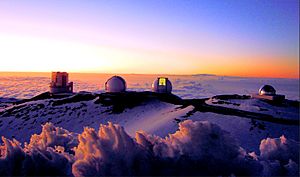
Mauna Kea's summit is one of the best places in the world for astronomical observation (looking at space). This is because of its high elevation, dry air, and stable airflow. The summit is above most clouds and pollution, making the air very clear. The skies are also very dark because it is far from city lights.
In the early 1960s, people in Hawaii wanted to build telescopes on Mauna Kea to help the economy. In 1964, tests confirmed that the summit was perfect for observing space. The University of Hawaiʻi (UH) received funding to build a large telescope. In 1968, UH was given a 65-year lease for the land around the telescope. When it was finished in 1970, the UH 88-inch telescope was one of the largest in the world.
By 1970, two more telescopes were built. In 1973, Canada and France agreed to build the 3.6-meter CFHT. However, local groups started to worry about how the observatories would affect the environment. This led to plans to manage the land better. In 1998, some land was moved from the observatory lease to the Mauna Kea Ice Age Reserve.
Today, the Mauna Kea Science Reserve has 13 observation facilities. These are funded by up to 11 different countries. There are telescopes that look at visible light, infrared light, submillimeter waves, and radio waves. Their mirrors or dishes range from 0.9 to 25 meters (3 to 82 feet) in size.
Debate Over New Telescopes
A group called "Save Mauna Kea" believes that building on the mountain is disrespectful because it is sacred. Native Hawaiian non-profit groups also oppose development for cultural and religious reasons.
A new telescope, the Thirty Meter Telescope (TMT), has caused a lot of debate and protests. The TMT was approved in 2013. But in 2014 and 2015, protesters blocked the road to the summit, stopping construction. People were arrested, and protests spread across the state. Construction was halted several times.
The Supreme Court of Hawaiʻi approved construction again in 2018. Protesters have created online petitions against the TMT and have called for the impeachment of Hawaiian Governor David Ige for supporting it.
As of late 2021, construction plans are on hold due to the COVID-19 pandemic and changes in funding. The debate continues, but polls show that most local residents support the project. However, support among Native Hawaiians is split.
In 2022, a new state law was passed to change how Mauna Kea is managed. A new 12-member board, the Mauna Kea Stewardship and Oversight Authority (MKSOA), was created. This board includes representatives from the university, astronomers, and native Hawaiians. Its goal is to find a balance between the different interests. The MKSOA will take over full management of the land by 2028. This means they will issue new land use permits, and any observatories without new leases by 2033 will be taken down.
Mauna Kea's Weather
Mauna Kea has an alpine climate (cold, high-mountain weather). Because it is near the equator, the temperature does not change much throughout the year. Frost is common all year, but the average monthly temperature stays above freezing.
Snow can fall at altitudes of 3,350 meters (11,000 feet) and above in any month. However, it snows most often from October to April.
| Climate data for Mauna Kea Observatory, elevation: 13,800 ft (4,206 m) | |||||||||||||
|---|---|---|---|---|---|---|---|---|---|---|---|---|---|
| Month | Jan | Feb | Mar | Apr | May | Jun | Jul | Aug | Sep | Oct | Nov | Dec | Year |
| Record high °F (°C) | 55 (13) |
56 (13) |
54 (12) |
55 (13) |
59 (15) |
58 (14) |
75 (24) |
57 (14) |
60 (16) |
59 (15) |
54 (12) |
55 (13) |
75 (24) |
| Mean daily maximum °F (°C) | 42.0 (5.6) |
42.5 (5.8) |
40.3 (4.6) |
41.4 (5.2) |
47.5 (8.6) |
49.3 (9.6) |
50.9 (10.5) |
49.9 (9.9) |
50.5 (10.3) |
43.8 (6.6) |
45.1 (7.3) |
42.7 (5.9) |
45.5 (7.5) |
| Mean daily minimum °F (°C) | 26.3 (−3.2) |
26.1 (−3.3) |
24.9 (−3.9) |
26.2 (−3.2) |
29.0 (−1.7) |
29.4 (−1.4) |
30.3 (−0.9) |
30.9 (−0.6) |
31.3 (−0.4) |
29.5 (−1.4) |
27.8 (−2.3) |
27.6 (−2.4) |
28.3 (−2.1) |
| Record low °F (°C) | 19 (−7) |
12 (−11) |
18 (−8) |
18 (−8) |
12 (−11) |
23 (−5) |
22 (−6) |
17 (−8) |
23 (−5) |
20 (−7) |
20 (−7) |
17 (−8) |
12 (−11) |
| Average precipitation inches (mm) | 0.81 (21) |
0.24 (6.1) |
1.05 (27) |
0.50 (13) |
0.92 (23) |
0.14 (3.6) |
0.29 (7.4) |
0.77 (20) |
0.51 (13) |
0.58 (15) |
1.04 (26) |
0.52 (13) |
7.37 (188.1) |
| Source: Western Regional Climate Center | |||||||||||||
Fun Activities on Mauna Kea
Mauna Kea's coast has rugged terrain with recreation parks like Kalopa State Recreation Area.
Hunting is a popular activity on Mauna Kea. There are over 3,000 registered hunters on Hawaii island. A public hunting program helps control the number of introduced animals like pigs, sheep, goats, and various birds. The Mauna Kea State Recreation Area is a base camp for hunters.
Birdwatching is also common at lower parts of the mountain. A popular spot is Kīpuka Puʻu Huluhulu. This is a kīpuka (an area of older land surrounded by newer lava flows) where a forest was isolated on a hill.
Mauna Kea's height and steep slopes offer great views. But its height can cause altitude sickness, and the weather can be tricky. The road is also very steep. Until roads were built in the mid-1900s, only strong hikers and hunters visited the upper slopes. They used stone cabins built in the 1930s as base camps. These cabins are now part of the modern Onizuka Center for International Astronomy telescope support complex. The first road to the summit was built in 1964, making it easier for more people to visit.
Today, there are several hiking trails, including the Mauna Kea Trail. Each year, between 5,000 and 6,000 people visit the summit. To keep everyone safe and protect the mountain, a ranger program was started in 2001.
Images for kids
-
To illustrate Mauna Kea's dry prominence, imagine raising the sea level of the Pacific Ocean to submerge the top of Mauna Kea. Then slowly lower it again. The first thing to appear is the peak of Mauna Kea. Then Mauna Loa and peaks of the surrounding Hawaiian Islands will emerge from the ocean. If the ocean drains further, the island around Mauna Kea will grow and merge with the adjacent islands. Continue draining until a land bridge forms between the Hawaiian Islands and a continent so that it is possible to walk all the way there without getting wet. Stop draining at this point, and this bridge is the key col of a dry Mauna Kea, connecting it to Mount Everest. Mauna Kea's peak stands 9,330 meters (30,610 feet) above this key col.
-
Hazard mapping of Mauna Kea and nearby Kohala
-
A stone structure or Ahu facing Mauna Kea, on Saddle Road between Mauna Kea and Mauna Loa
-
David Douglas, a Scottish botanist who died on Mauna Kea in 1834
-
Sunset over four telescopes of the Mauna Kea Observatories. From left to right: the Subaru Telescope, the twin Keck I and II telescopes, and the NASA Infrared Telescope Facility.
-
Mauna Kea silversword (Argyroxiphium sandwicense sandwicense) growing near the volcano's summit
-
A pair of māmane (Sophora chrysophylla) trees
-
The ʻalalā or Hawaiian crow (Corvus hawaiiensis) is a bird in the crow family. It is extinct in the wild, with plans to reintroduce the species into the Hakalau Forest National Wildlife Refuge.
 In Spanish: Mauna Kea para niños
In Spanish: Mauna Kea para niños
- Evolution of Hawaiian volcanoes
- List of mountain peaks of the United States
- List of tallest mountains in the Solar System
- List of the highest major summits of the United States
- List of the most isolated major summits of the United States
- List of the most prominent summits of the United States
- List of Ultras of Oceania


